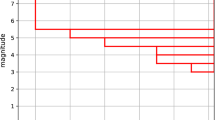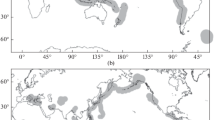Abstract
Bayes' theorem has possible application to earthquake prediction because it can be used to represent the dependence of the inter-arrival time (T) of thenext event on magnitude (M) of thepreceding earthquake (Ferraes, 1975;Bufe et al., 1977;Shimazaki andNakata, 1980;Sykes andQuittmeyer, 1981). First, we derive the basic formulas, assuming that the earthquake process behaves as a Poisson process. Under this assumption the likelihood probabilities are determined by the Poisson distribution (Ferraes, 1985) after which we introduce the conjugate family of Gamma prior distributions. Finally, to maximize the posterior Bayesian probabilityP(τ/M) we use calculus and introduce the analytical condition\(\frac{d}{{d\tau }}P(\tau /M) = 0\).
Subsequently we estimate the occurrence of the next future large earthquake to be felt in Mexico City. Given the probabilistic model, the prediction is obtained from the data set that include all events withM≥7.5 felt in Mexico City from 1900 to 1985. These earthquakes occur in the Middle-America trench, along Mexico, but are felt in Mexico City. To see the full significance of the analysis, we give the result using two models: (1) The Poisson-Gamma, and (2) The Poisson-Exponential (a special case of the Gamma).
Using the Poisson-Gamma model, the next expected event will occur in the next time interval τ=2.564 years from the last event (occurred on September 19, 1985) or equivalently, the expected event will occur approximately in April, 1988.
Using the Poisson-Exponential model, the next expected damaging earthquake will occur in the next time interval τ′=2.381 years from the last event, or equivalently in January, 1988.
It should be noted that very strong agreement exists between the two predicted occurrence times, using both models.
Similar content being viewed by others
References
Abe, K. (1981),Magnitudes of large shallow earthquakes from 1904 to 1980. Phys. Earth Planet Inter.27, 72–92.
Benjamin, J. R. andCornell, C. A. Probability, Statistics, and Decision for Civil Engineers (McGraw-Hill, 1970).
Bath, M. (1965),Lateral inhomogeneities of the upper mantle, Tectonophysics51, 483–514.
Bufe, C. G., Harsh, P. W. andBuford R. O. (1977),Steady-state seismic slip: A precise recurrence model. Geophys. Res. Lett.4, 91–94.
Ferraes, S. G. (1975),Statistical and probabilistic dependence between magnitude and time-intervals for Mexico City earthquakes, TELLUS27 (5), 529–537.
Ferraes, S. G. (1985),The Bayesian probabilistic prediction of strong earthquakes in the Hellenic Arc. Tectonophysics11, (3–4), 339–354.
Ferraes, S. G. (1986),Bayes theorem and the probabilistic prediction of inter-arrival times from strong earthquakes felt in Mexico City, J. Phys. Earth34, 71–83.
Figueroa, J.,Las zonas sismicas de Mexico. Anales del Instituto de Geofisica (UNAM), Vol. 11, 1956.
Gnedenko, B. V.,The Theory of Probability (Chelsea Publishing Company, New York, N. Y., 1968).
Meyer, P. L.,Introductory Probability and Statistical Applications (Addison-Wesley Publishing Company, 1972).
Olsson, R. (1982),The randomness of major global earthquakes, Tectonophysics82, T11-T15.
Richter, C. F.,Elementary Seismology (W. H. Freeman & Co., San Francisco, California, 1958).
Shimazaki, K. andNakata T. (1980),Time-predictable model for large earthquakes, Geophys. Res. Lett.7 (4), 279–282.
Singh, S. K., Astiz, L. andHavskov J. (1981),Seismic gaps and recurrence periods of large earthquakes along the Mexican subduction zone: A reexamination, Bull. Seism. Soc. Am. 71, 827–843.
Singh, S. K., Rodriguez, M. andEsteva, L. (1983),Statistics of small earthquakes and frequence of occurrence of large earthquakes along the Mexican subduction zone, Bull. Seism. Soc. Am.73, 1779–1796.
Singh, S. K., Rodriguez, M. andEspindola J. M. (1984),A catalog of shallow earthquakes of Mexico from 1900 to 1981. Bull. Seism. Soc. Am.74 (1), 267–279.
Sykes, L. R. andQuittmeyer, R. C., inEarthquake Prediction. An International Review, Maurice Ewing Series 4 (ed. D. W. Simpson and P. G. Richards) (Washington D. C., 1981) p. 217.
Taylor, L. D.,Probability and Mathematical Statistics (Harper and Row, New York, 1974).
Winkler, R. L. andHays, W. L. Statistics: Probability, Inference, and Decision (Holt, Rinehart and Winston, 1975).
Rights and permissions
About this article
Cite this article
Ferraes, S.G. The optimum Bayesian probability procedure and the prediction of strong earthquakes felt in Mexico city. PAGEOPH 127, 561–571 (1988). https://doi.org/10.1007/BF00881744
Received:
Revised:
Accepted:
Issue Date:
DOI: https://doi.org/10.1007/BF00881744




